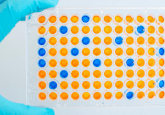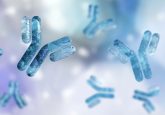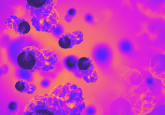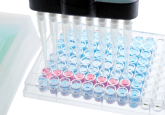Scientists demonstrate draining method speeds up bioassays

Scientists at the University of Washington (WA, USA) have developed a cyclic draining method that could speed up bioassays. Their method aims to tackle the problem of slow diffusion of bulky detector molecules and could reduce waiting times to a fraction of what they once were. Their work was recently published in the journal Small.
Many biological assays use large detector molecules such as antibodies to detect specific types of cellular proteins or DNA strands. The detector molecules are specific, binding selectively to their target molecules, and include components such as dye molecules or nanoparticles. Such assays have helped diagnose disease and support drug development.
A major problem with bioassays is that they take hours or days to complete. Detector molecules float in solution while their targets are adhered to the hard flat surface of a plate or a petri dish. Bulky detector molecules close to this surface can easily find and bind to their targets; however, molecules further up in the column can take a long time to diffuse to the surface due to their size. It can take hours for enough detector molecules to diffuse down and bind to their targets to produce a visible color change.
“We call this ‘diffusion limitation,’ and it’s a serious problem since both the antibody and nanoparticles are so large,” commented Xiaohu Gao, a University of Washington associate professor of bioengineering and senior author on the paper. “People have proposed solutions – like stirring or gently rocking a reaction plate to mix the solution. But when we tested this we saw that stirring and rocking only improved the reaction time by 3–5 %. That’s not enough.”
Gao and his team sought to tackle diffusion limitation after they developed a new staining assay, which was rendered impractical by the long reaction times. Instead of waiting for detector molecules to drift down to the surface they allowed time for detector molecules close to the surface to bind, they then drained the solution from the plate, mixed it, and put it back on the plate. They repeated this cycle dozens of times, naming the technique ‘cyclic solution draining and replenishing’.
Fluid was drained from the plate, by covering the plate with a seal and inverting it. To ‘re-soak’ the plate they flipped it upright again. The flipping action also helped mix detector molecules in fluid, speeding up the total reaction time.
The team tested the cyclic solution draining with two types of antibody staining techniques – ELISA and immunofluorescence microscopy. They found that reaction times were cut in both instances, in one case what was once a 1 hour incubation time was reduced to just 7 minutes. It must be noted that sealing and flipping the plate might be impractical for other tests, however there are other ways the plate can be ‘drained’.
“We used gravity because we wanted to show that draining would work,” continued Gao. “But you could use air bubbles or centrifugation to drain as well, for example. There are lots of possibilities.”
This technique holds promise and could tackle the problem of diffusion limitation, slashing waiting times for experiments. This could impact many fields, reducing waiting times for medical test results and speeding up chemical engineering protocols.
Sources: Li J, Zrazhevskiy P, Gao X. Eliminating Size-Associated Diffusion Constraints for Rapid On-Surface Bioassays with Nanoparticle Probes. Small. DOI: 10.1002/smll.201503101 (2016); Stir no more: UW scientists show that draining speeds up bioassays.






